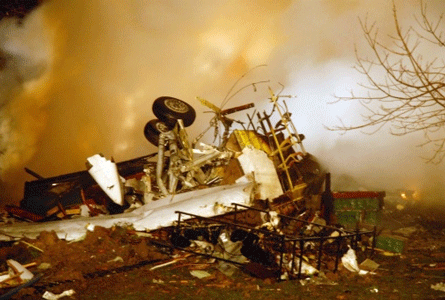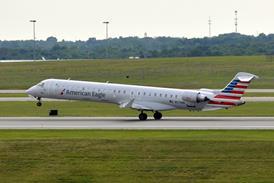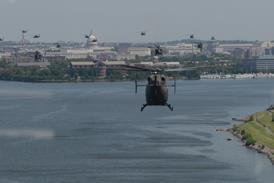Prior to its re-scheduling, exhibitors at the NBAA annual convention were quietly confident. Unlike the recession of the early 1990s, the association's president Jack Olcott said business aircraft orders were unlikely to suffer too much, as they were now business necessities. The events of 11 September have pushed demand in two directions, however, and the full impact will not be clear for some months.
Attendance is down for the revised convention. The association estimates that only a third of those with tickets for the September event will attend. Exhibitors are also well down on September, but despite this, manufacturers are putting a lot of faith in the event for converting the increased interest in their products into orders.
The attraction of business jets has always been their flexibility. The appeal of being able to fly at several hours' notice has been highlighted by the frustration of taking internal US flights post-11 September. Lacking the equipment and skills to rapidly implement European levels of security, airports in the USA have instead resorted to what the International Air Transport Association's director general, Pierre Jeanniot called "silliness driven by the need to be seen to be secure".
The business traveller is as likely to have his nail-clippers confiscated after a search as anyone else. Though necessary, until more sophisticated methods become available, the added inconvenience of flying through US terminals has increased interest in business aviation.
Furthermore, the first routes cut in the airlines' recent culling were from secondary airports. Business travel between minor cities has therefore become a lot more wearisome.
Added to this is the perception that business jets, either wholly owned, part of a fractional plan or even chartered, offer more protection against the threat of hijacking than commercial jets. It is certainly more comforting to know your travelling companions. Indeed, all three sections of the industry operators are showing interest levels rising by a third. The US Charter Guide reports bookings by members up by 28%; one leading fractional ownership scheme, Flight Options, has reversed a predicted order fall and has increased its prediction for 2002; and one mid-sized company in the Midwest says that its flight department is now flying 30% more of its staff due to reduced airline schedules.
There are calls for greater security in the sector too. For although all passengers may know each other, neither the pilots, nor those on the ground need know who is on board except the lead passenger. Olcott says that despite his organisation's success in overturning some of the less "well-informed" initial reactions to the heightened security needs, the business aviation community is working with the agencies involved in the Homeland Security Council to ensure continued flying. This may result in a change in new security acts being put before US Congress, not least because the FBI is nervous about aircraft flying over major cities carrying unknown and unscreened passengers. Final rules are expected to mandate that all charter aircraft with maximum take off weights of more than 5,700kg (12,500lb) must implement stricter security measures akin to commercial flights.
In return, Olcott expects greater use of waivers - screened exceptions to the stricter rules - for VFR restrictions in the enhanced class B airspace around Boston, New York and Washington DC. NBAA is confident that a system of "security letter of authorisation", whereby operators are vetted by US Federal Aviation Administration Flight Standards District Offices, which liaise with the FBI, CIA and secret services, will come into place. "The next time the nation has to clamp down on security, business aviation will be better prepared," says Olcott.
Yet, however strong the desire to fly cocoon class in a corporate jet, there are loud noises coming from the finance departments of major corporations investigating such moves. Costs are being cut as companies' order books dry up. Travel budgets are particularly badly affected. If the US economy, which officially slipped into recession in March could have recovered, then surely the attacks will deepen its impact. Olcott disagrees. Rather, he argues, business aviation is a tool to drive business recovery: "Corporations want to be able to control the costs of their two most valuable resources: people and time." Olcott estimates that as company sales departments "work the problem harder", flying hours will increase.
The NBAA estimates that on a typical trip for four executives flying from the New York metropolitan area to Austin, Texas, it is cheaper flying in a corporate jet than in a commercial airliner. The calculations, made with its proprietary software, Travelsense, assume full-fare changeable first class fares, an overnight stay in a plush hotel and lost man-hours, but nevertheless, many more businesses are coming around to the idea that flying offices doing same-day returns make sense in tougher economic conditions. This is especially true of those companies that realise that you do not need to buy an entire aircraft to make this option a reality.
Fractional ownership is likely to be a major beneficiary of the post-terrorism market. Given the lead time on new aircraft, an instant corporate jet settles staff qualms about travelling. Furthermore, with increasingly small fractions available from the fractionals themselves and time-shares on fractions being offered by such companies as Marquis Jet Partners, which offers as little as 25 occupied hours of corporate jet use, the idea of a limo in the sky, available at short notice and capable of transporting key employees safely and quickly, is still enticing. Marquis chief executive, Alan Clingman says: "trends in private jet travel point to a demand for a programmes that targets an increasingly younger client, who may not be ready for full fractional aircraft ownership".
United Airlines' fractional arm Avolar has placed its bets on the Airbus Corporate Jet, which will be exhibited at the show. It is positioning itself at the corporate shuttle end of the fractional market. Other fractionals, suffering from a drop-off in dotcom bookings, are also exploring new markets. Capacity overall is unlikely to grow much, but neither will it be slashed like airlines'. The major six fractional ownership companies were hiring fewer pilots before September, according to Atlanta, Georgia-based pilot salary analysts, AIR Inc. Between Corporate Aircraft Partners, Citation Shares, Flexjet, Flight Options, NetJets, and Travel Air, pilot hiring was down 30% on the same period last year. Utilisation of fractional hours, however, is rising, and the knock-on effect in fuel sales, ground handling and flight administration should convince the majors to abandon aircraft deferment plans they had been considering before September.
The price stimulation of the market at the beginning of the year, caused by both ramped-up production schedules among the major players and the first effects of the economic slowdown, has driven prices down. Despite this, the market is holding up, says Tony Friend, president of Aircraft Shopper Online, an internet brokerage. It carried out a survey of over 1,400 aircraft dealers last month, about a fifth of the total. Its figures show that based on the level of firm interest shown since 11 September, most expect to see a slight to moderate increase in aircraft sales. Dealers specialising in light jets are the most optimistic, with 70% expecting to see some kind of increase, however modest. This compares with 69% of turboprop dealers, 64% of medium-sized jet dealers and 52% of heavyweight jet dealers.
Friend believes that only sales of piston-engined aircraft, which are largely playthings of executives rather than company productivity tools, will decline. Already weakened by a sluggish economy, companies hit by cost-cutting among customers have been hit by operational restrictions. According to the US General Aviation Manufacturers Association, deliveries of new aircraft to private individuals were down for the first three quarters of 2001, despite billings for the entire aviation industry being slightly up. In short, the market is likely to remain static. This is better than the slight decline forecast by manufacturers for the middle of next year.
Bombardier, for example, has revised this year's target for business jet deliveries downwards to 180. This is down on its original projection of 200 because of the worsening financial situation, but so far the Canadian manufacturer is unsure of the impact of 11 September - its 2002 forecast is still unpublished and it has yet to lay off workers from its business aircraft division in large numbers.
Friend sees the mid-size market as the core segment. "These guys are saying 'to hell with the airlines'. When they look at their mission requirements they realise that they need a mid-size jet rather than a turboprop or light jet."
Most analysts and industry insiders refuse to give an opinion on how badly they expect the market to be affected. Most think that the market will pick up again in as little as six months. This is in line with an IATA survey on corporate travel, which polled flight departments of major US companies. While few people thought that travel would increase in the last part of this year, 57% expected normality to return within six months. Lee Monson, Boeing Business Jet president, estimates that the increased interest shown in business aviation as a result of 11 September will lead to personal relationships being sealed at NBAA, but that actual sales will lag at least three months behind, with six months looking more realistic. Only once firm orders are in, will the company review its production schedule.
Source: Flight International























